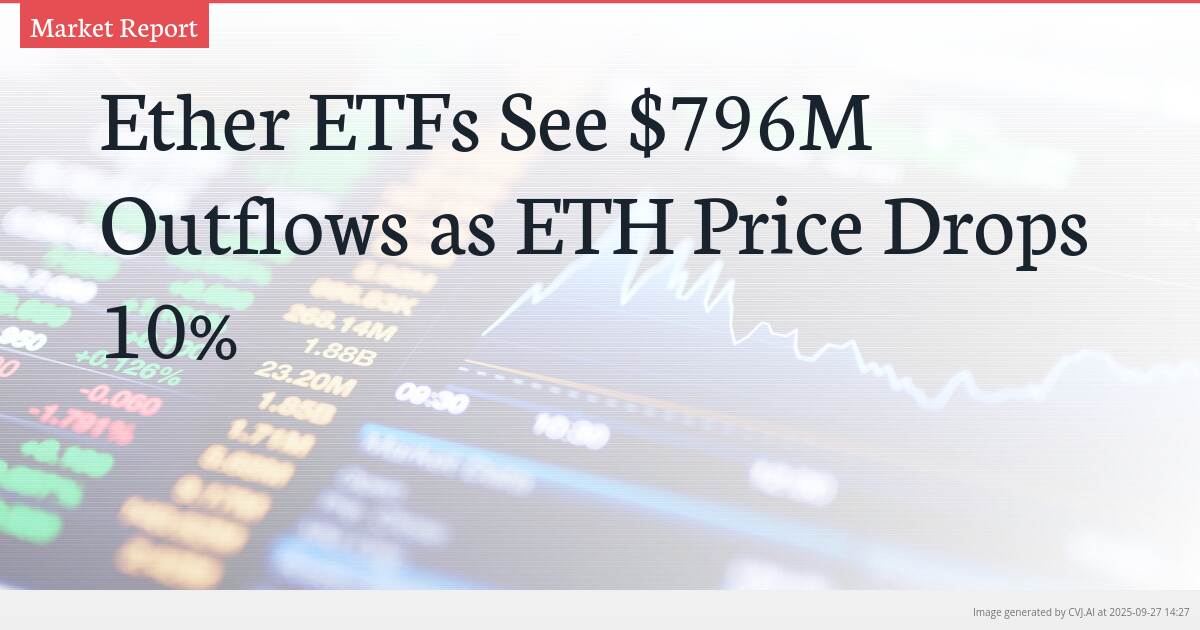This summary text is fully AI-generated and may therefore contain errors or be incomplete.
Introduction
U.S. spot Ether exchange-traded funds are facing a severe test of investor confidence, recording five consecutive days of net outflows totaling $795.8 million as the price of Ether itself cratered by over 10%. This synchronized downturn, revealed by data from Farside Investors and CoinMarketCap, points to a rapid cooling of retail participation and raises significant questions about the near-term trajectory for the world’s second-largest cryptocurrency.
Key Points
- Spot Ether ETFs recorded $248.4 million in outflows on Friday, contributing to a weekly total of $795.8 million.
- Ether’s price declined by 10.25% over the week, falling to $4,013 according to CoinMarketCap.
- The outflows and price drop suggest weakening retail interest and possibly shifting investor sentiment.
A Week of Sustained Selling Pressure
The bleeding for spot Ether ETFs in the United States was both consistent and substantial throughout the trading week. According to Farside data, the outflows culminated in a significant $248.4 million withdrawal on Friday alone, cementing a negative trend that had persisted for five straight sessions. This brought the total capital flight from these newly launched investment vehicles to a staggering $795.8 million for the week. The consistent nature of the outflows suggests a coordinated shift in sentiment rather than isolated profit-taking, indicating a broader reassessment of Ether’s immediate prospects among institutional and larger retail investors.
This wave of selling from the ETFs occurred against a backdrop of general market volatility, but the magnitude and duration of the outflows are particularly noteworthy. For an asset class that promoters argue brings stability and legitimacy, the rapid exit of nearly $800 million in a single week presents a challenging narrative. The data underscores that the initial enthusiasm that greeted the approval of these products may be giving way to a more cautious, wait-and-see approach as macroeconomic uncertainties and crypto-specific headwinds persist.
Ether's Price Decline Mirrors ETF Outflows
The weakness in the ETF market was directly reflected in the spot price of Ether. Data from CoinMarketCap showed that over the same seven-day period, the price of ETH fell by 10.25%, trading at $4,013 at the week’s end. This parallel decline is critical; it demonstrates a strong correlation between the flows of capital in and out of the ETFs and the underlying asset’s market value. The outflows from the ETFs likely contributed to downward pressure on the spot price, as authorized participants may have been forced to sell ETH to meet redemption requests.
The 10% price drop is a sharp reversal for an asset that many expected to find renewed support from the ETF launch. The decline pushed Ether below several key psychological and technical support levels, potentially triggering further automated selling. This price action suggests that the anticipated influx of mainstream capital via ETFs has, for now, failed to materialize at a scale sufficient to counteract prevailing bearish sentiment. Instead of acting as a price floor, the ETF market has become a conduit for selling pressure.
Signals of Weakening Retail Participation
Beyond the raw numbers, the most concerning signal for Ether bulls may be the implication of weakening retail participation. The simultaneous outflows from the relatively accessible ETFs and the drop in spot price indicate a pullback from the smaller, often more sentiment-driven, retail investor base. These investors are typically more susceptible to short-term price movements and negative headlines, and their retreat can amplify volatility.
This trend raises questions about the sustainability of the current crypto market structure. If retail interest, a key driver of past bull cycles, is indeed waning, the market may become increasingly reliant on institutional flows which are often more strategic and less frequent. The data from this week serves as a stark reminder that ETF approval is not a guarantee of perpetual demand. It merely provides a new mechanism for investment, and that mechanism can just as easily facilitate exits as it can entries. The coming weeks will be crucial in determining whether this is a temporary setback or the beginning of a more prolonged period of caution for Ether.
📎 Read the original article on cointelegraph.com

